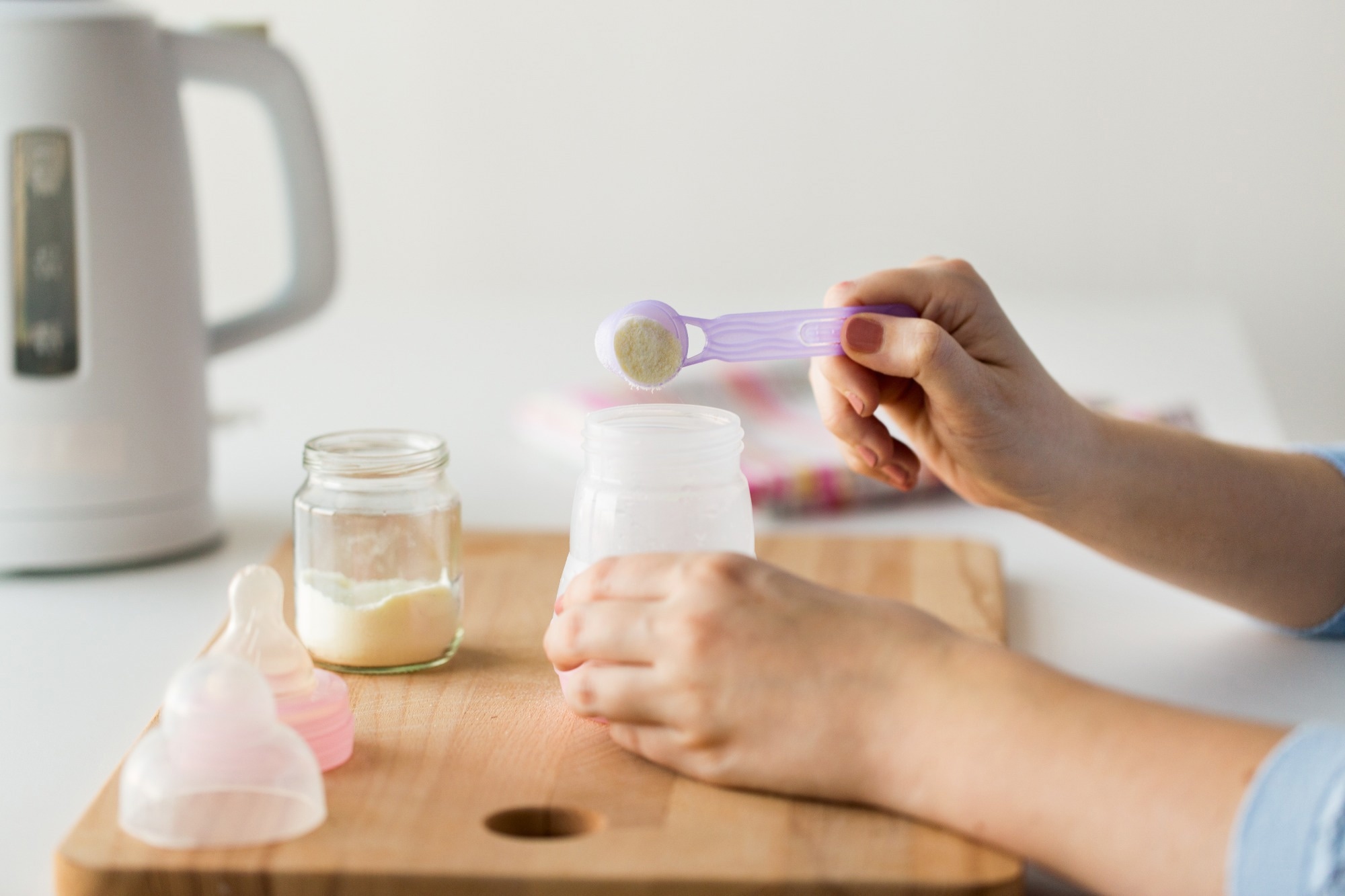A new UK study reveals that even when parents follow recommended 70°C preparation guidelines, powdered infant formula can harbor resilient microbes, and that popular at-home machines might make things worse.
 Study: Infant formula milk shows microbiological contaminants that are not removed using recommended preparation methods. Image credit: Ground Picture/Shuterstock.com
Study: Infant formula milk shows microbiological contaminants that are not removed using recommended preparation methods. Image credit: Ground Picture/Shuterstock.com
Powdered infant formula (PIF) is among the most widely used infant foods. They are reconstituted using recommended preparation methods, often with the aid of at-home preparation machines (APHM). However, even when these guidelines are followed, the final preparation still contains microbial contaminants, according to a paper recently published in the Journal of Applied Microbiology.
Baby formula preparation matters
The mode of infant feeding influences the infant gut microbiome, which plays a crucial role in immunomodulation and the development of immune tolerance. PIF-fed babies develop a distinct microbiome compared to exclusively breastfed infants. Babies exposed to pathogens like B. cereus, which is known to cause severe outbreaks among infants, may potentially experience adverse immune responses or gastrointestinal inflammation, although this remains theoretical.
PIFs are produced under an extended manufacturing process that allows for potential microbial contamination at multiple points. This may include spore-forming bacteria, such as Bacillus and Clostridium, or non-spore-forming bacteria, like Listeria monocytogenes, which can survive pasteurization. Several batches of PIF have been recalled for failure to meet mandated microbiological testing standards. Still, even so, there is ample opportunity for PIFs to contain bacteria that fall outside these limits, bacteria that can cause serious illness in newborns.
Both the World Health Organization (WHO) and the UK National Health Service (NHS) have guidelines for PIF preparation to minimize the risk of bacterial contamination. Both recommend using freshly boiled water at a temperature of approximately 70°C, with the formula being cooled to the right temperature for drinking before feeding the infant.
This policy is based on earlier evidence that common environmental bacteria, which are opportunistic pathogens, are easily destroyed by moderate heat. However, only 44% of parents boil fresh tap water for formula preparation; many prefer to use previously boiled, cooled water. Again, most APHMs (85%) do not reach the recommended temperature, despite being used by 52% of parents.
There is a need to understand how aerobic bacteria, environmental or otherwise, affect the microbiological quality of prepared formula, including that prepared via AHPMs.
Detecting microbial contamination
The investigators purchased 21 brands/types of PIF from commercial outlets in the UK, representing the most available products in the age range of newborn to six months. These were then prepared by three methods in parallel:
- sterile 70°C water
- sterile room temperature water
- a popular AHPM
The preparations were then cultured for bacterial growth using Tryptic soy agar (TSA) and Sabouraud dextrose agar (with added chloramphenicol (50 mg/L)) (SAB) plates, growing only bacteria and yeasts, respectively. The isolates were identified via sophisticated mass spectrometry methods.
Microbes detected
Only five and three products showed no microbial growth on TSA and SAB media, respectively. In the vast majority of AHPM preparations, microbial contamination was observed, at 16/21 and 18/21 on TSA and SAB, respectively.
In contrast, only 5/21 and 4/21 products had recoverable microbes with other methods of preparation. Notably, preparations using room temperature water and 70°C water did not show a statistically significant difference in the level of microbial contamination.
The microbial counts varied according to the method of preparation and the PIF brand. The bacterial counts were consistently higher than the yeasts.
Within the same brand, the method of preparation changed the final microbial count in four cases. However, microbial levels remained similar across brands and types of product. About 85% of recovered microbes belonged to three genera.
Interestingly, the formula prepared using an AHPM had distinct microbial patterns. Even sterile water run through the appliance showed microbial growth, indicating the problem may lie in the filters.
The researchers estimate that “Based on the bacterial recovery counts from PIF product in this work, and on typical feeding volumes for a three month old infant, this could equate to an infant receiving approximately 106 CFU of bacteria per day.” Notably, this is an order of magnitude lower than that received through exclusive breastfeeding, but it comprises a different set of microbes.
When milk was heated to 65°C and higher, B. cereus levels dropped. However, viable B. cereus cells persisted even at 100°C, though at much lower concentrations. Some of the pathogens recovered from AHPM formula included temperature-resistant B. cereus. In heating treatment experiments, yeasts such as Candida albicans became unrecoverable at 70°C, though this does not necessarily mean all yeasts were eliminated under general preparation conditions.
One of the three B. cereus isolates showed resistance to imipenem and meropenem, both classed as critically important antimicrobials.
Exposure to potentially transferable resistance could pose as a risk factor for gastrointestinal infections.
The results suggest, though do not confirm, that antibiotic resistance genes may be transferred among microbes during the PIF manufacturing process.
Safety guidelines may need updating
Currently, the guidelines for PIF reconstitution may not eliminate all microbial contaminants. Approximately one in three analytes exhibited microbial growth, even when prepared with water at 70 °C. These bacteria appear to be primarily from the environment and may impact the development of the infant microbiome during this critical window.
This suggests that public health guidelines should be assessed against the range of products available in the infant feeding market, and adjusted accordingly.
However, the authors note that their experiments were carried out under highly controlled laboratory conditions. The actual risk of infection from PIF in the home remains low, though improper preparation or unclean equipment could increase exposure.
They also emphasize that no cases of infant infection were observed in this study, and that PIF remains a safe feeding option when prepared and stored according to public health recommendations.
Download your PDF copy now!